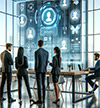Revolutionary Advances in Life Sciences amid Industry Disruption and Uncertainty
Pharma and biotech companies as well as medical-device manufacturers are transforming the healthcare sector.
Q4 2014

According to Deloitte LLP’s Terry Hisey, vice chairman and U.S. life sciences sector leader, 2014 is expected to be a good year for U.S. life sciences companies. “The country will see a fair number of ACA initiatives, such as health insurance exchanges, moving from proposed and enacted to implementation,” he says. “ACA-related pharmaceutical industry fees, a new medical device tax, and lower government drug prices, however, could negatively impact growth.”
The ACA and its associated fees and taxes have created a level of disruption and uncertainty - this unease, however, can also represent opportunities for innovative companies to become new leaders and gain market share. For example, with ACA’s emphasis on reimbursement for performance, healthcare systems, pharmaceutical and biotechnology companies, and medical device manufacturers are targeting products and devices that will reduce healthcare costs, such as less-invasive surgical procedures, shorter hospital stays, and improved disease management.
The country will see a fair number of ACA initiatives, such as health insurance exchanges, moving from proposed and enacted to implementation…ACA-related pharmaceutical industry fees, a new medical device tax, and lower government drug prices, however, could negatively impact growth. Terry Hisey, Vice Chairman and U.S. Life Sciences Sector Leader, Deloitte LLP
Transforming Healthcare
One developing trend is increased interest in patient-centered “medical homes” - a model of care that includes integrated care delivered by a primary-care team of physicians and other specialists, the use of telemedicine and “virtual visits,” self-monitoring of health conditions, and home-care services. This emphasis on at-home care and personalized medicine has led to a rapid increase in the development of multi-functional, at-home medical devices and wearable sensors/devices that can transmit accurate health data in real time to physicians, call centers, and the patients themselves.
Another hot area of life sciences research is cell therapy, which has huge potential for personalizing medicine and improving rates of successful treatment for serious diseases. This rapidly expanding field of gene therapy can repair damaged genes in diseased cells, using the patient’s own DNA.
“We now have the technology to generate stem cells from a sample of the patient’s skin, correct the genetic mutation in those cells, and return the ‘gene-corrected’ cells back to the patient for therapy,” says David Rowitch, professor of pediatrics and neurological surgery at the University of California-San Francisco. “These cells have the advantage of containing the patient’s own genetic code, so they escape rejection by the body’s immune system.”
…emerging clusters in Denver, central/southern Florida, Chicago, Cleveland, Salt Lake City, Dallas/Fort Worth, Indianapolis, Atlanta, and Wisconsin are starting to compete with established clusters, supported by attractive incentive packages, incubator assistance, and public-private partnerships… JLL 2014 Life Sciences Cluster Report According to JLL’s 2014 Life Sciences Cluster report, based on employment concentration and growth, as well as funding and patents, the top-10 U.S. life sciences clusters are located in the metro areas of Boston, San Francisco, San Diego, Raleigh-Durham, New Jersey/New York, Los Angeles/Orange County, Philadelphia, Maryland/Metro D.C., Minneapolis-St. Paul, and Seattle. Yet, emerging clusters in Denver, central/southern Florida, Chicago, Cleveland, Salt Lake City, Dallas/Fort Worth, Indianapolis, Atlanta, and Wisconsin are starting to compete with established clusters, supported by attractive incentive packages, incubator assistance, and public-private partnerships.
Some of these regions are starting to score big successes. For example, in Madison, Wisconsin, Exact Sciences Corporation recently announced the Mayo Clinic will be the first health system to offer its new product Cologuard®, the first and only FDA-approved, noninvasive DNA screening test for colorectal cancer. “Cologuard represents a significant advancement in identifying colorectal cancer at its most treatable stage,” says Vijay Shah, chair of Mayo Clinic’s gastroenterology department. “We believe this new tool will promote patient and community public health and may move more patients to get screened earlier — a critical step in beating this prevalent and preventable cancer.”
Medical Device Sector
The U.S. medical device industry is the largest in the world and is known for its innovation and groundbreaking products. It continues to design devices and implants that incorporate smaller and complex designs and advanced materials to create less-invasive procedures. These products bring down the cost of healthcare by delaying or eliminating the need for surgery, reducing hospital stays, and improving patient outcomes.
According to the Advanced Medical Technology Association, advanced medical technology helped reduce the duration of hospital stays by 58 percent between 1980 and 2010. Today the industry employs about two million U.S. workers and generates nearly $150 billion in annual revenues.
Although the ACA has significantly increased the patient pool for medical devices, it also hit the medical device industry with a 2.3 percent excise tax to help cover the insurance for these new participants. Medical device manufacturing is highly competitive, and many companies were already struggling with costs prior to the announcement of the tax.
According to the U.S. Chamber, the medical device tax has already resulted in a job loss of 33,000 in the medical device industry, with 132,000 more job losses expected. The tax has sobered growth prospects, slowed investment and R&D, and delayed hiring. In an effort to offset the tax losses, medical device companies hope to sell more products to emerging markets like China, India, and Brazil.
Top medical device clusters in Minnesota, Indiana, Massachusetts, and California are key contributors to their state economies. For example, in California, medical device manufacturing encompasses 300,000 direct and indirect jobs and generates nearly $60 billion for the state’s economy.
This is not the next evolutionary advance in medicine…This is a revolutionary advance. It is a change in the whole ethos of how we approach medical problems that everybody in the medical world, and for that matter, people outside the medical world, can get excited about. Michael Drues, President, Vascular Sciences
Minnesota employs about 300,000 life science employees and is home to the Mayo Clinic, the largest integrated medical center in the world. In Minneapolis/St. Paul, 22 percent of employees work in the medical technology sector; in fact, the Twin Cities are first in total per capita employment in that sector.
Massachusetts continues to be a world-class medical device cluster. Medical devices are its biggest export, comprising about 13 percent of its international trade. This vibrant cluster continues to attract investment. For example, GE Healthcare Life Sciences recently announced it plans to open a new $21 million, 160,000-square-foot U.S. headquarters building in Marlborough, creating more than 220 new jobs.
“Our new facility in Massachusetts will position us for continued innovation and competition in such a fast-paced, innovative industry,” states Kieran Murphy, president and CEO of GE Healthcare Life Sciences. “We will be close to industry leading talent, customers, and world-class academic and medical institutions across all the industry sectors we serve, from biotech and pharma to diagnostics and medical devices.”
Emerging states include Ohio, Florida, and Georgia. In Florida, more than 60,000 workers in the medical device sector generate about $12.5 billion in annual revenues. Georgia’s medical device industry is growing rapidly, anchored by the Centers for Disease Control, the Georgia Institute of Technology, and Emory University’s biomedical engineering program. In Ohio, Cleveland is becoming a highly respected medical device cluster. Medical device companies work closely with the region’s biomedical research organizations, including the highly acclaimed Cleveland Clinic and its affiliated Cleveland Clinic Innovations. Another Cleveland Clinic affiliate, the Lerner Research Institute, focuses on biomedical engineering, genomics, molecular cardiology, stem cell biology, and cancer research.
“Cleveland Clinic and its affiliates have been leaders in spurring medical device design and development in the Cleveland area,” comments Brian Hrouda, director of sales and marketing for Norman Noble, a Cleveland area contract manufacturer for the medical industry. “Their research and development teams have been very successful at implementing the steps required to commercialize new medical device technologies.”
Best of Both Worlds
“Combination devices” — products that combine a device with a drug and/or biologic — are at the forefront of life sciences/medical device research and development. Examples of therapeutic or diagnostic combination products include biologically or drug-eluting implants or stents, surgical meshes with antibiotic coatings or biological gels, drug delivery devices, bone graft implants with antibiotic-loaded cements, inhalers, transdermal patches, and intraocular implants. Transparency Market Research reports that the global market for drug-device combination products is expected to grow from about $70 billion today to $115 billion in 2019, representing a compounded annual growth rate of 7.9 percent.
“There are combination products under development today that involve many more things than just drugs, biologics, and medical devices,” says Michael Drues, president of Vascular Sciences, a Grafton, Massachusetts, consulting company. “They involve a variety of technologies, foods and nutraceuticals, and even cosmetics, or so-called ‘cosmeceuticals.’”
Drues explains that combination products are gaining popularity because they hold the promise of not simply preventing the damage from a disease or injury from getting worse, but actually reversing or erasing the damage. “This is not the next evolutionary advance in medicine,” he notes. “This is a revolutionary advance. It is a change in the whole ethos of how we approach medical problems that everybody in the medical world, and for that matter, people outside the medical world, can get excited about.”
Project Announcements
BioStem Technologies Plans Boca Raton, Florida, Headquarters Operations
12/06/2025
AstraZeneca Expands Frederick-Gaithersburg Maryland, Manufacturing Operations
11/29/2025
South Korean-Based Nature Cell Plans Baltimore City, Maryland, Production Operations
11/19/2025
Regeneron Pharmaceuticals Plans Saratoga Springs, New York, Manufacturing Operations
11/17/2025
AndHealth Expands Columbus, Ohio, Headqurters Operations
11/14/2025
Taiwan-Based Bora Pharmaceuticals Expands Baltimore, Maryland Operations
11/13/2025
Most Read
-
The Workforce Bottleneck in America’s Manufacturing Revival
Q4 2025
-
Rethinking Local Governments Through Consolidation and Choice
Q3 2025
-
Lead with Facts, Land the Deal
Q3 2025
-
Investors Seek Shelter in Food-Focused Real Estate
Q3 2025
-
America’s Aerospace Reboot
Q3 2025
-
The Permit Puzzle and the Path to Groundbreaking
Q3 2025
-
Supply Chain Whiplash Reshapes CRE
Q3 2025



